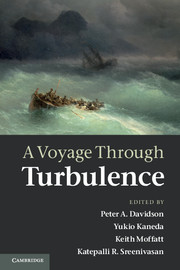Book contents
- Frontmatter
- Contents
- List of contributors
- Preface
- 1 Osborne Reynolds: a turbulent life
- 2 Prandtl and the Göttingen school
- 3 Theodore von Kármán
- 4 G.I. Taylor: the inspiration behind the Cambridge school
- 5 Lewis Fry Richardson
- 6 The Russian school
- 7 Stanley Corrsin
- 8 George Batchelor: the post-war renaissance of research in turbulence
- 9 A.A. Townsend
- 10 Robert H. Kraichnan
- 11 Satish Dhawan
- 12 Philip G. Saffman
- 13 Epilogue: a turbulence timeline
- References
13 - Epilogue: a turbulence timeline
Published online by Cambridge University Press: 07 October 2011
- Frontmatter
- Contents
- List of contributors
- Preface
- 1 Osborne Reynolds: a turbulent life
- 2 Prandtl and the Göttingen school
- 3 Theodore von Kármán
- 4 G.I. Taylor: the inspiration behind the Cambridge school
- 5 Lewis Fry Richardson
- 6 The Russian school
- 7 Stanley Corrsin
- 8 George Batchelor: the post-war renaissance of research in turbulence
- 9 A.A. Townsend
- 10 Robert H. Kraichnan
- 11 Satish Dhawan
- 12 Philip G. Saffman
- 13 Epilogue: a turbulence timeline
- References
Summary
To supplement the foregoing chapters, we offer below a table listing some key developments in turbulence research over the period covered by this book, i.e. roughly up to mid-1970s. Later developments involving massive computations, low-dimensional dynamics, the renormalization group, turbulence control, modern instrumentation, and so on, are not included; nor do we include such closely related areas as turbulent thermal convection, combustion, wave turbulence, or the vast field of applications in geophysics, astrophysics and plasma physics. Moreover, the table is ‘internal’ to the subject, in that we make no attempt to relate the events to developments in other scientific fields or to the wider historical context. Despite these limitations, it is our hope that the table, necessarily subjective to some extent, will provide a useful point of reference for the reader. We thank the authors of this book for their comments on the table, especially Professor R. Narasimha for the inspiration he provided.
- Type
- Chapter
- Information
- A Voyage Through Turbulence , pp. 426 - 434Publisher: Cambridge University PressPrint publication year: 2011



